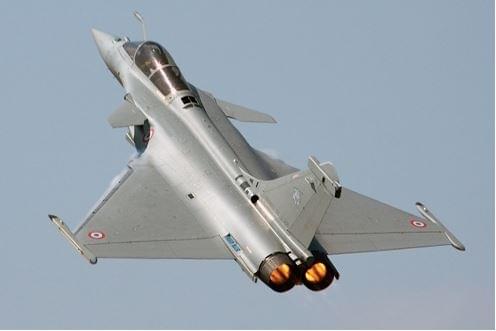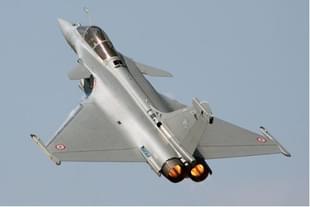Economy
What Ails Military Acquisition Programmes In India?
Mihir Shah
Feb 23, 2015, 08:51 PM | Updated Feb 11, 2016, 08:33 AM IST
Save & read from anywhere!
Bookmark stories for easy access on any device or the Swarajya app.


A step-by-step account of the problems with India’s military acquisition programmes
There’s always a certain buzz in the air at the biennial Aero India exhibition, an event that has arms vendors from all over the world flocking to showcase their wares to countries hungry for modern military equipment. This year, with the new government initiating an extensive military modernisation program, that buzz only grew louder.
And yet, the souring of the multi-billion dollar deal for the Dassault Rafale multi-role combat aircraft has come to serve as a stark reminder that any hopes of those ambitious plans translating to reality may yet be stillborn.
The problem is not restricted to the Rafale deal alone. Across the board, major programs are suffering from time and cost overruns, with some even running the risk of outright cancellation. All of this has brought concerns with the current procurement system into sharp focus. This column attempts to deconstruct and provide some insight into the three major issues that convolute military procurement programs in India.

(A Dassault Rafale of the French Air Force. The aircraft won the Indian Air Force’s ₹82,000 crore competition for 126 multi-role fighters. But problems with Dassault’s bid and lack of funding have put the deal in jeopardy. Photo credit: Paul Nelhams (https://flic.kr/p/fAgKCz) )
Absence of Long-Term Planning
Independent India’s defence strategy has been largely directionless. The lack of a national strategic vision and the absence of political direction have meant that each branch of the armed forces has been left to pursue its own operational doctrine. This has had a direct bearing on weapons acquisition, which until very recently, was ad-hoc and reactionary, driven more by critical shortages and political compulsions rather than any detailed long-term roadmap. For instance, the Air Force’s MiG-29 and Mirage-2000 fighters were purchased as a knee-jerk reaction to Pakistan’s acquisition of F-16s, and the INS Vikramaditya was practically shoved down an unwilling Navy’s throat.
Shortfalls in Funding
For a country that desires a strong, well-equipped military, India earmarks a rather modest amount of money for defence-related expenditure. At 1.74% of the GDP, the 2014 defence budget was the lowest in 52 years.
Much of this budget has been historically allocated to “revenue expenditure” — the cost of keeping the armed forces running. The Army, for example, which was allocated nearly half the total budget, spent more than 80% of that money on revenue expenditure. It is not difficult to see why. With 1.2 million personnel, it is perhaps the largest standing army in the world, ahead of the Chinese PLA. Those troops have to be paid, housed, fed, trained, equipped, and generally taken care of. Indeed, two-thirds of the Army’s revenue budget is consumed by payroll alone.
Of the money left over for capital expenditures, not all is available for force modernization initiatives. A large fraction goes towards “committed liabilities“, or installment payments for equipment that has already been purchased. This leaves very little room in the budget for capital expenditures required to purchase new equipment.
And yet, the military’s appetite for modern weaponry — most of it sourced from abroad — appears insatiable. Between 2011 and 2014, India spent ₹83,458 crore on arms procurement from foreign vendors alone, and there is no sign of a let up in new acquisitions.
The upshot of these issues is that often, there simply isn’t enough money to pay for committed liabilities and new acquisitions at the same time, leading to negotiations for new programs being drawn out until more money becomes available. The situation is so bad that last year, the Ministry of Defence (MoD) was said to have deliberately stalled the negotiations on the Rafale because there was no money left in the budget.
Flawed Procurement Procedures
The Indian weapons procurement system is a product of the Bofors Scandal. In the 1980s, there were allegations that the Swedish firm Bofors AB bribed Indian politicians and officials in order to win a contract for 155 mm artillery. The scandal was seen to bring down a government that was voted into power after securing a historic majority. Consequently, a strong system of checks and balances was instituted to ensure that there was no impropriety in the procurement of weapons. In simple terms, the Defence Procurement Procedure (DPP) works like this:
– The armed forces write a set of functional requirements, called Staff Qualitative Requirements (SQRs), on the basis of which they formulate performance specifications.
– Competitive tenders are invited on the basis of these requirements and specifications.
– The equipment offered by contractors that respond to the tenders is put through a series of comprehensive trials, after which, the ones that pass make the down-select.
– The MoD then negotiates with the vendors that make the down-select, and finalises the system that offers the lowest life-cycle cost.
In theory, this ensures that everything is done by the book, and the armed forces get the best possible system at the lowest possible cost. In practice, it mires pretty much every contract in red tape, leading to years (if not decades) of delays and price increases.
It is often said that the road to hell is paved with good intentions. This system is striking example of how that happens. The armed forces often write what are jokingly called “Best of Brochure” specifications. They look at glossy brochures printed by arms vendors, and use the claims made therein (claims that are often exaggerated/unrealistic except in the most ideal of conditions) to define unreasonable performance criteria. It comes as no surprise that more often than not, no contractor can meet all the requirements. Time is wasted as performance requirements and specifications are re-written, watered down, and then re-written again until they achieve a modicum of realism. Of course, the moment anyone waters down the specifications, they invite allegations of wrongdoing to favour some contractor, which only stalls a program further.
Sometimes, the specifications turn out such that only one contractor meets the requirements. This is called a “single-vendor situation”, something the MoD tries to avoid like the plague. When a single-vendor situation occurs, the armed forces are forced to re-write specs and re-issue tenders. The result is further delays and price increases. A very good example of such waffling is the 155 mm artillery tender. The program was so shoddily run that the tender was re-issued five times over a span of twenty-five years because either the specs were ridiculously unreasonable, or the Army kept getting itself into a single-vendor situation.

Another problem lies with the MoD’s “two-step” procedure for evaluating competing offers. The initial down-select is often made on technical criteria alone, with other factors — like the life-cycle cost of a weapon and the political reliability of a supplier — ignored. On paper, this ensures that the armed forces evaluate weaponry based on well-defined performance parameters, without the more abstract considerations clouding the assessment and giving the appearance of impropriety. In reality, this prevents a proper cost-benefit analysis from being carried out in the early stages of an acquisition, eliminating bids that could have provided a better “bang for the buck” in favour of cost-prohibitive solutions. Moreover, the elimination of alternative options at an early stage weakens India’s negotiating position with the winning vendor over issues of cost and transfer of technology.
Making matters worse is the MoD’s penchant for blacklisting vendors at the slightest hint of impropriety. That badly hurts procurement. For instance, South Africa’s Denel was blacklisted owing to irregularities in the procurement of anti-material rifles. Given their immense firepower, these rifles played a key role in destroying Pakistani fortifications during the Kargil War. The ban on Denel, while politically expedient, put Indian soldiers stationed at the LoC at increased risk of Pakistani fire. It also meant that the company, which was co-developing a self-propelled howitzer with the DRDO, had to pull out of a promising program to equip the Army with a homegrown weapon. Without its participation, the project ground to a halt. In 2009, The MoD also blacklisted Israeli Military Industries (IMI). At the time, IMI was supplying India with ammunition for its T-72 tanks, Bofors howitzers, and all sorts of small arms. It was also setting up a factory in Nalanda to manufacture ammunition locally. By blacklisting Denel, IMI, and a host of other companies, the MoD shot itself in the foot, putting military preparedness at risk and stymying efforts towards defence indigenisation.
Concluding Remarks
If there is one thing the system has taught us over the last three decades, it is that articulating a vision for military modernisation is the easy part. But unless that vision is backed up by action — action that sees the Indian security apparatus define a unified national strategic vision, makes the military a leaner force, boosts budgets, and transforms the procurement system to deliver equipment to the armed forces in a timely, cost-efficient, manner — procurement programs will keep dragging on for years, leaving the nation with critical gaps in military capability. This does not bode well for a country that is faced with an ever-more unstable Pakistan on one side and an increasingly belligerent China on the other.
Mihir Shah is a mechanical engineer who tracks military and aerospace issues closely. He has contributed to to LiveFist Defence, Pragati Magazine, and Bharat Rakshak’s Security Research Review.





